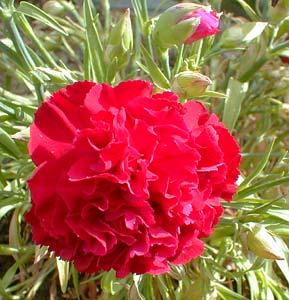
'Desmond Red' Carnation
"So spicy her Carnations nod --
So drunken, reel her Bees --
So silver steal a hundred flutes
From out a hundred trees"
-Emily Dickinson
1830‚1886
1830‚1886
Diantus plumarius 'Desmond' is a very old variety of carnation, & very popular. It is the one that ends up in front of grocery stores & may be spotted at hospital bedsides or in graveyards in plastic pots wrapped in color tinfoil. Though I wouldn't personally have bought one, as a gift during a garden party it was a perfectly nice thing to add as filler into one of the sun-gardens, & I've had more pleasure from it than I could've predicted.
The name Dianthus was given by Linneaus in 1737. It means Deity Flower. The Red signifies the god Ares. The popularity of the particular god-flower 'Desmond' is due to its reliability for intensely scarlet spicily fragrant double-flowers, & for the long bloom time that begins mid spring & lasts through all of summer. In our moderate climate it reblooms in September & may unfold "one more flower after another" all the way to the beginning of November.
Carnation blooms are edible. With petals pulled apart, they can be used to sprinkle color & spicy scent over the surface of a leafy salad, perhaps also with the addition of a few honeysuckle trumpets & nasturtiums.
'Desmond' likes well-drained organically rich but slightly alkaline soil, but does well enough in our naturally acidic soils. They don't generally require much if any fertilizer, except that in our acidic soils they might benefit from a bit of lime.
Since its clumps remain fairly short, & their odor is so wonderful, they belong at the front of a garden. Note, however, that carnations are not long-lived. When it begins to seem unnecessarily unsightly, it's best to just discard it, but with a good location in plenty of sun & not too wet, it'll last three or four good years. Dead blooms should be trimmed back, but carnations don't otherwise like much pruning, though withering old stems can be plucked out.
Our winters tend to be pretty mild, so D. plumarius sometimes holds up as an evergreen perennial, its attractively silvered olive-green leaves having providing decent out-of-season presence even at the height of winter.